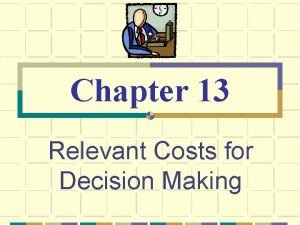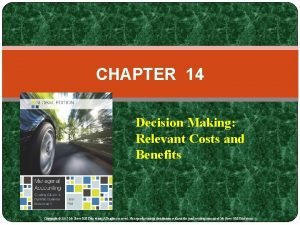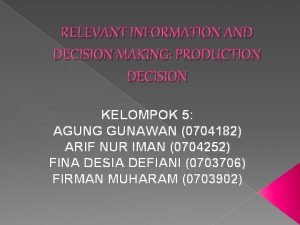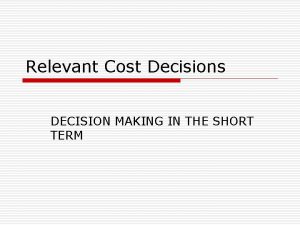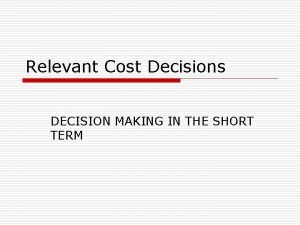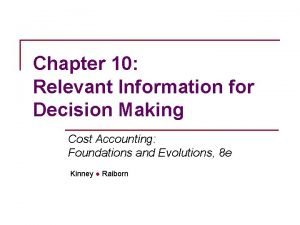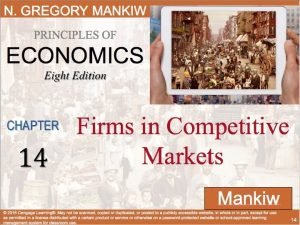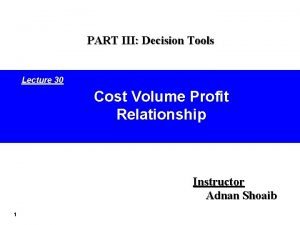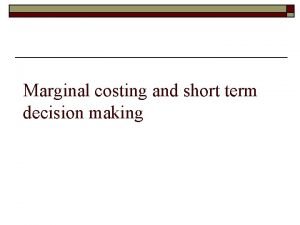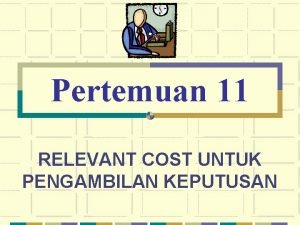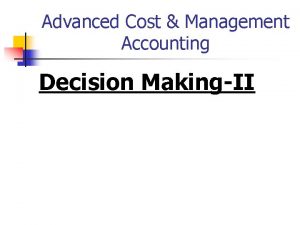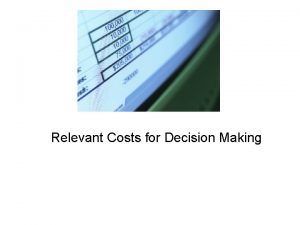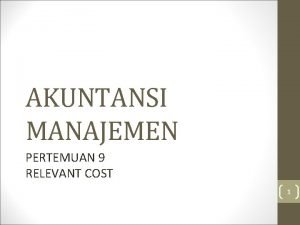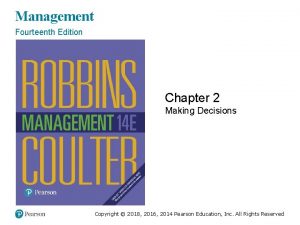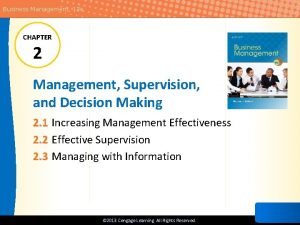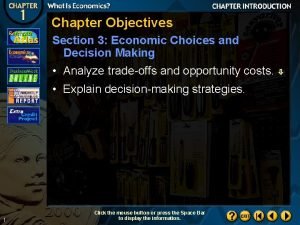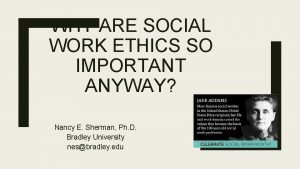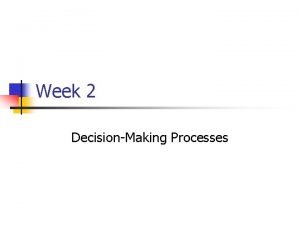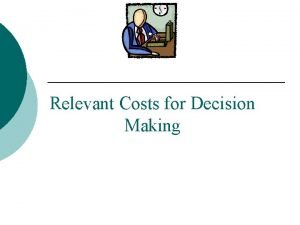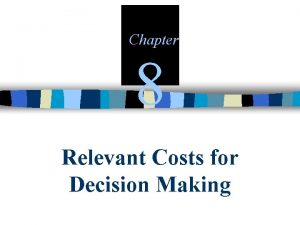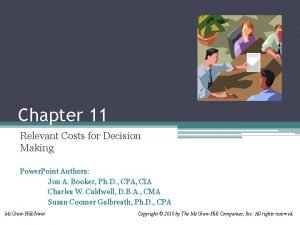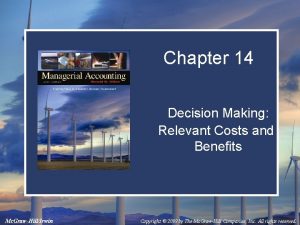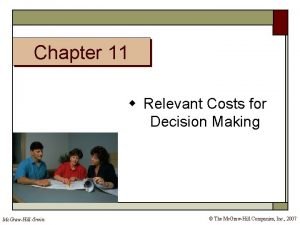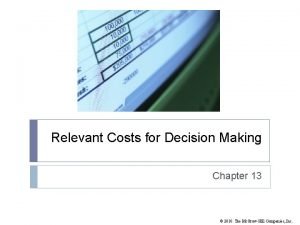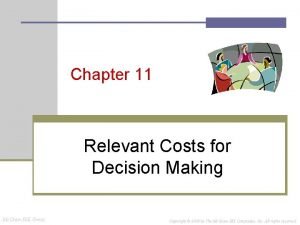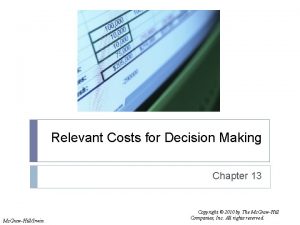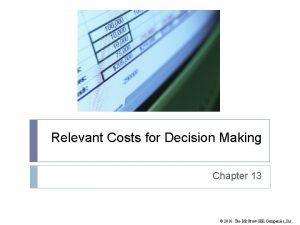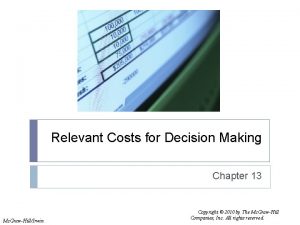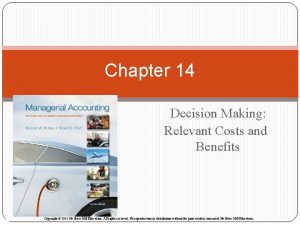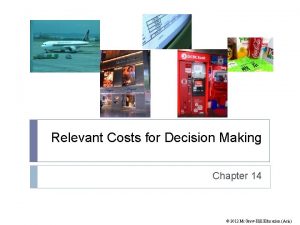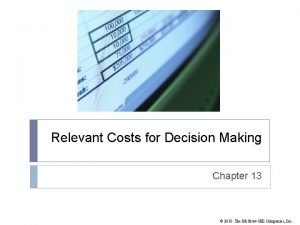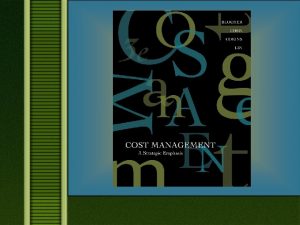Chapter 12 Relevant Costs for Decision Making Cost







































- Slides: 39

Chapter 12 Relevant Costs for Decision Making

Cost Concepts for Decision Making A relevant cost is a cost that differs between alternatives. 1 Mc. Graw-Hill/Irwin 2 © The Mc. Graw-Hill Companies, Inc. , 2003

Identifying Relevant Costs that can be eliminated (in whole or in part) by choosing one alternative over another are avoidable costs. Avoidable costs are relevant costs. Unavoidable costs are never relevant and include: Sunk costs. Future costs that do not differ between the alternatives. Mc. Graw-Hill/Irwin © The Mc. Graw-Hill Companies, Inc. , 2003

Identifying Relevant Costs Cynthia, a Boston student, is considering visiting her friend in New York. She can drive or take the train. By car it is 230 miles to her friend’s apartment. She is trying to decide which alternative is less expensive and has gathered the following information: Mc. Graw-Hill/Irwin © The Mc. Graw-Hill Companies, Inc. , 2003

Identifying Relevant Costs Mc. Graw-Hill/Irwin © The Mc. Graw-Hill Companies, Inc. , 2003

Identifying Relevant Costs Which costs and benefits are relevant in Cynthia’s decision? The cost of the car is a sunk cost and is not relevant to the current decision. The annual cost of insurance is not relevant. It will remain the same if she drives or takes the train. However, the cost of gasoline is clearly relevant if she decides to drive. If she takes the drive the cost would now be incurred, so it varies depending on the decision. Mc. Graw-Hill/Irwin © The Mc. Graw-Hill Companies, Inc. , 2003

Identifying Relevant Costs Which costs and benefits are relevant in Cynthia’s decision? The cost of maintenance and repairs is relevant. In the long-run these costs depend upon miles driven. The monthly school parking fee is not relevant because it must be paid if Cynthia drives or takes the train. At this point, we can see that some of the average cost of $0. 569 per mile are relevant and others are not. Mc. Graw-Hill/Irwin © The Mc. Graw-Hill Companies, Inc. , 2003

Identifying Relevant Costs Which costs and benefits are relevant in Cynthia’s decision? The decline in resale value due to additional miles is a relevant cost. The round-trip train fare is clearly relevant. If she drives the cost can be avoided. Relaxing on the train is relevant even though it is difficult to assign a dollar value to the benefit. The kennel cost is not relevant because Cynthia will incur the cost if she drives or takes the train. Mc. Graw-Hill/Irwin © The Mc. Graw-Hill Companies, Inc. , 2003

Identifying Relevant Costs Which costs and benefits are relevant in Cynthia’s decision? The cost of parking is relevant because it can be avoided if she takes the train. The benefits of having a car in New York and the problems of finding a parking space are both relevant but are difficult to assign a dollar amount. Mc. Graw-Hill/Irwin © The Mc. Graw-Hill Companies, Inc. , 2003

Identifying Relevant Costs From a financial standpoint, Cynthia would be better off taking the train to visit her friend. Some of the non-financial factor may influence her final decision. Mc. Graw-Hill/Irwin © The Mc. Graw-Hill Companies, Inc. , 2003

Total and Differential Cost Approaches The management of a company is considering a new laborsaving machine that rents for $3, 000 per year. Data about the company’s annual sales and costs with and without the new machine are: Mc. Graw-Hill/Irwin © The Mc. Graw-Hill Companies, Inc. , 2003

Total and Differential Cost Approaches As you see, the only costs that differ between the alternatives are the direct labor costs savings and the increase in fixed rental costs. We can efficiently analyze the decision by looking at the different costs and revenues and arrive at the same solution. Mc. Graw-Hill/Irwin © The Mc. Graw-Hill Companies, Inc. , 2003

Adding/Dropping Segments One of the most important decisions managers make is whether to add or drop a business segment such as a product or a store. Let’s see how relevant costs should be used in this decision. Mc. Graw-Hill/Irwin © The Mc. Graw-Hill Companies, Inc. , 2003

Adding/Dropping Segments Due to the declining popularity of digital watches, Lovell Company’s digital watch line has not reported a profit for several years. An income statement for last year is shown on the next screen. Mc. Graw-Hill/Irwin © The Mc. Graw-Hill Companies, Inc. , 2003

Adding/Dropping Segments Mc. Graw-Hill/Irwin © The Mc. Graw-Hill Companies, Inc. , 2003

Adding/Dropping Segments Investigation has revealed that total fixed general factory overhead and general administrative expenses would not be affected if the digital watch line is dropped. The fixed general factory overhead and general administrative expenses assigned to this product would be reallocated to other product lines. Mc. Graw-Hill/Irwin © The Mc. Graw-Hill Companies, Inc. , 2003

Adding/Dropping Segments The equipment used to manufacture digital watches has no resale value or alternative use. Should Lovell retain or drop the digital watch segment? Mc. Graw-Hill/Irwin © The Mc. Graw-Hill Companies, Inc. , 2003

A Contribution Margin Approach DECISION RULE Lovell should drop the digital watch segment only if its profit would increase. This would only happen if the fixed cost savings exceed the lost contribution margin. Let’s look at this solution. Mc. Graw-Hill/Irwin © The Mc. Graw-Hill Companies, Inc. , 2003

A Contribution Margin Approach Mc. Graw-Hill/Irwin © The Mc. Graw-Hill Companies, Inc. , 2003

Comparative Income Approach The Lovell solution can also be obtained by preparing comparative income statements showing results with and without the digital watch segment. Let’s look at this second approach. Mc. Graw-Hill/Irwin © The Mc. Graw-Hill Companies, Inc. , 2003

If the digital watch line is dropped, the company gives up its contribution margin. Mc. Graw-Hill/Irwin © The Mc. Graw-Hill Companies, Inc. , 2003

On the other hand, the general factory overhead would be the same. So this cost really isn’t relevant. Mc. Graw-Hill/Irwin © The Mc. Graw-Hill Companies, Inc. , 2003

But we wouldn’t need a manager for the product line anymore. Mc. Graw-Hill/Irwin © The Mc. Graw-Hill Companies, Inc. , 2003

If the digital watch line is dropped, the net book value of the equipment would be written off. The depreciation that would have been taken will flow through the income statement as a loss instead. Mc. Graw-Hill/Irwin © The Mc. Graw-Hill Companies, Inc. , 2003

Mc. Graw-Hill/Irwin © The Mc. Graw-Hill Companies, Inc. , 2003

Beware of Allocated Fixed Costs Why should we keep the digital watch segment when it’s showing a loss? Mc. Graw-Hill/Irwin © The Mc. Graw-Hill Companies, Inc. , 2003

Beware of Allocated Fixed Costs The answer lies in the way we allocate common fixed costs to our products. Mc. Graw-Hill/Irwin © The Mc. Graw-Hill Companies, Inc. , 2003

Beware of Allocated Fixed Costs Our allocations can make a segment look less profitable than it really is. Mc. Graw-Hill/Irwin © The Mc. Graw-Hill Companies, Inc. , 2003

The Make or Buy Decision A decision concerning whether an item should be produced internally or purchased from an outside supplier is called a “make or buy” decision. Let’s look at the Essex Company example. Mc. Graw-Hill/Irwin © The Mc. Graw-Hill Companies, Inc. , 2003

The Make or Buy Decision Essex manufactures part 4 A that is used in one of its products. The unit product cost of this part is: Mc. Graw-Hill/Irwin © The Mc. Graw-Hill Companies, Inc. , 2003

The Make or Buy Decision The special equipment used to manufacture part 4 A has no resale value. The total amount of general factory overhead, which is allocated on the basis of direct labor hours, would be unaffected by this decision. The $30 unit product cost is based on 20, 000 parts produced each year. An outside supplier has offered to provide the 20, 000 parts at a cost of $25 per part. Should we accept the supplier’s offer? Mc. Graw-Hill/Irwin © The Mc. Graw-Hill Companies, Inc. , 2003

The Make or Buy Decision 20, 000 × $9 per unit = $180, 000 Mc. Graw-Hill/Irwin © The Mc. Graw-Hill Companies, Inc. , 2003

The Make or Buy Decision The special equipment has no resale value and is a sunk cost. Mc. Graw-Hill/Irwin © The Mc. Graw-Hill Companies, Inc. , 2003

The Make or Buy Decision Not avoidable; irrelevant. If the product is dropped, it will be reallocated to other products. Mc. Graw-Hill/Irwin © The Mc. Graw-Hill Companies, Inc. , 2003

The Make or Buy Decision Should we make or buy part 4 A? Mc. Graw-Hill/Irwin © The Mc. Graw-Hill Companies, Inc. , 2003

The Make or Buy Decision DECISION RULE In deciding whether to accept the outside supplier’s offer, Essex isolated the relevant costs of making the part by eliminating: eliminating The sunk costs. l The future costs that will not differ between making or buying the parts. l Mc. Graw-Hill/Irwin © The Mc. Graw-Hill Companies, Inc. , 2003

Opportunity Cost The benefits that are foregone as a result of pursuing some course of action. Opportunity costs are not actual dollar outlays and are not recorded in the formal accounts of an organization. Mc. Graw-Hill/Irwin © The Mc. Graw-Hill Companies, Inc. , 2003

Quick Check Which of the following are opportunity costs of attending the university? a. Tuition. b. Books. c. Lost wages. d. Not enough time for other interests. Mc. Graw-Hill/Irwin © The Mc. Graw-Hill Companies, Inc. , 2003

Quick Check Which of the following are opportunity costs of attending the university? a. Tuition. b. Books. c. Lost wages. d. Not enough time for other interests. Opportunity costs do not have to involve money. Mc. Graw-Hill/Irwin © The Mc. Graw-Hill Companies, Inc. , 2003
 Relevant cost for decision making solution chapter 13
Relevant cost for decision making solution chapter 13 Relevant cost for decision making exercises
Relevant cost for decision making exercises Five step decision making process
Five step decision making process Chapter 11 decision making and relevant information
Chapter 11 decision making and relevant information Chapter 11 decision making and relevant information
Chapter 11 decision making and relevant information Decision making and relevant information
Decision making and relevant information Decision making and relevant information
Decision making and relevant information Decision making and relevant information
Decision making and relevant information Decision making and relevant information
Decision making and relevant information Relevant information for decision making
Relevant information for decision making Sunk costs are irrelevant for decision making
Sunk costs are irrelevant for decision making Cvp income statement
Cvp income statement Objectives of decision making
Objectives of decision making Financial decision
Financial decision Short term decision making in marginal costing
Short term decision making in marginal costing Five-step decision-making process cost accounting
Five-step decision-making process cost accounting Relevant cost adalah
Relevant cost adalah Relevant cost in management accounting
Relevant cost in management accounting Relevant costing
Relevant costing Pengertian relevant cost
Pengertian relevant cost Chapter 6 prices and decision making assessment answers
Chapter 6 prices and decision making assessment answers Chapter 2 economic systems and decision making answer key
Chapter 2 economic systems and decision making answer key Management chapter 5 planning and decision making
Management chapter 5 planning and decision making Financial decision making process
Financial decision making process Chapter 2 economic systems and decision making
Chapter 2 economic systems and decision making Chapter 2 decision making
Chapter 2 decision making Chapter 2 economic systems and decision making
Chapter 2 economic systems and decision making Chapter 2 management supervision and decision making
Chapter 2 management supervision and decision making Options-based planning
Options-based planning Chapter 1 section 3 economic choices and decision making
Chapter 1 section 3 economic choices and decision making Cost incurrence and locked-in costs
Cost incurrence and locked-in costs Benefits of job order costing
Benefits of job order costing Decision table and decision tree examples
Decision table and decision tree examples Youth involvement
Youth involvement Ethical rules screen nasw code of ethics
Ethical rules screen nasw code of ethics Systematic decision making process
Systematic decision making process Paced decision making
Paced decision making Mamdm
Mamdm Using functions in models and decision making
Using functions in models and decision making What is this image
What is this image
